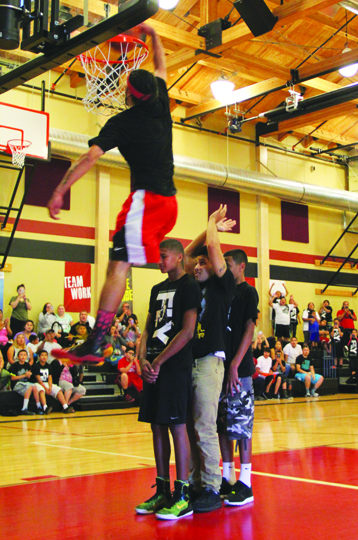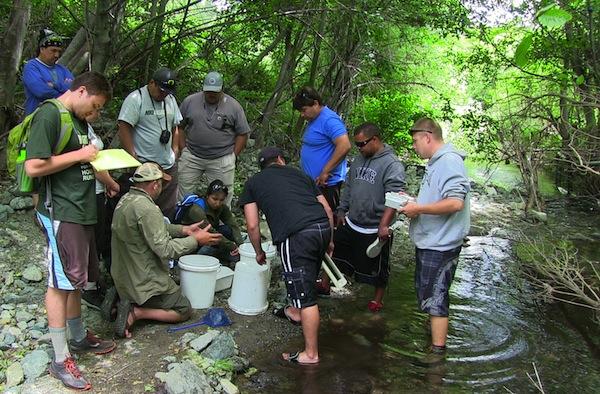Tag: youth
Super Dunker, Kenny Dobbs, shares story and talent with Tulalip Youth
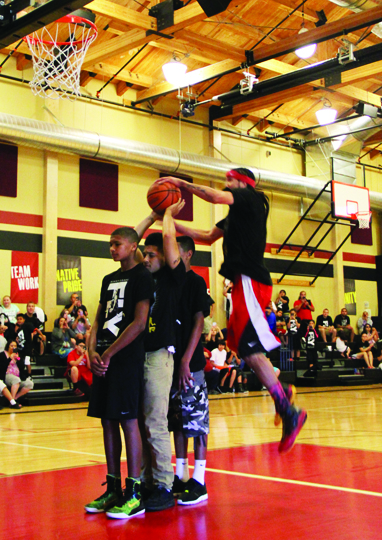
Photos/Micheal Rios
by Micheal Rios, Tulalip News
On Thursday, May 28, the Higher Education Department held a special event for Tulalip’s youth at the Greg Williams Gym. They made it possible for the youth to come together for an evening consisting of every youth’s choice of dinner, pizza and Gatorade, while experiencing the unique talents of super dunker and motivational speaker, Kenny Dobbs. Every youth who attended the event also received their choice of a Kenny Dobbs ‘Fly’ or ‘Dream Catcher’ t-shirt.
Dobbs is a member of the Choctaw Nation of Oklahoma, Phoenix resident and professional basketball player, but is most notably recognized as the self-proclaimed ‘King of the Dunk Game’. He has toured the NBA while being sponsored by Sprite as a celebrity dunker, performing in front of sold-out stadiums during halftime shows, celebrity games and NBA All-Star Weekends. Becoming a Sprite Slam Dunk Champion and International Slam Dunk Champion means Dobbs’ dunking talents have become globally recognized. As his reputation has soared sky high, like his vertical leaping ability, Dobbs never forgot where he came from and who he is representing. He now tours across the nation, going reservation to reservation as a motivational speaker for tribal youth to share his story of hope and to perform his dunking abilities while doing so.
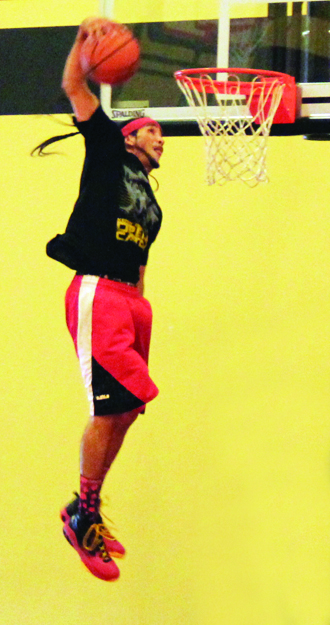
Photo/Micheal Rios
“I’m so excited to be here and you guys are so lucky to be able to grow up in such a beautiful community,” Dobbs said to the estimated 150 Tulalip youth in attendance. “Today, the main theme is for me to be able to come out and have a good time with you guys. It’s going to get personal as I share who I am and what I’ve come from. By sharing my story I want all of you to know that I’m somebody that you relate to and can learn from. Today, I stand before you all as an International Slam Dunk Champion, but before any of that became reality there was a lot of challenges and difficulties I was facing in my life. Similar to a lot of you I’m sure.”
As an adolescent, Dobbs grew up in a drug and gang related neighborhood in Phoenix and found himself going down the wrong road. After a series of personal conflicts with his parents, run-ins with the law, dropping out of high school, and a lengthy stay in a jail cell, Dobbs realized his life had become a nightmare and the only way out was to make wholesale changes to his lifestyle. After being set free from his self-made incarceration, Dobbs began to set himself free from everything else that had been holding him back in life. He started with his friends; anyone who had drug or gang affiliations he cut ties with, anyone who brought more negative energy than positive energy was also cut loose.
As mentioned earlier, Dobbs dropped out of high school. He was 15 years-old at the time and got into a physical fist fight with his dad and was kicked out of his house. Soon after followed his stint in jail. At 17 years-old he found himself with no real high school education, no place to call his home, and no future prospect other than what he believed he could do. To hold himself accountable and to ensure he was staying on the right road for future success, Dobbs created what he calls his ‘Dream Journal’.
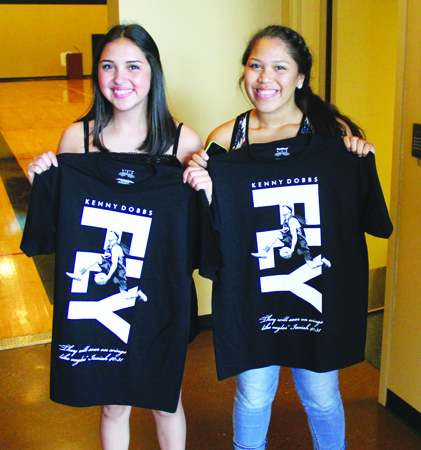
Photo/Micheal Rios
“I began writing down all my goals and dreams on paper. In that notebook I began to explain how I wanted to become a professional athlete and positive role model for my family, my home, and my community,” explained Dobbs. “I wrote down all my goals, big or small, and from that point on I continued to learn from that process. It was taking the goals and the dreams from my mind and my heart and actually putting them down on paper. They became something that I not only thought about, but that I saw as well. I began to write the steps it was going to take for me to accomplish those goals and dreams, so as I took them out of my mind and onto paper now I could read them and see them. They became reality to me and to this day I still keep myself a dream journal and all that went into there was, what are my goals, what are my dreams, and then I’d break it down step by step so I knew what I’d have to do to accomplish my goals and reach my dreams. The very first goal I ever set in my life was getting my high school diploma.”
At the time Dobbs had no clue how much work and dedication it would take him to achieve the goal of receiving his high school diploma, but he was determined and that’s all that mattered. It would take two hard years, no winter breaks, no summer breaks, all day and evening school sessions for Dobbs to accumulate enough credits to reach his goal. He remained focused and grinded every day at his studies until he received his diploma.
“To this day that was the very first goal I set, stuck with, and accomplished in my life. Now when I went to school that day and they handed me my high school diploma that was a sense of accomplishment I never felt before. I committed two years of non-stop grinding, of blood, sweat and tears that I committed to achieving my goal. Now, there is no possibility of me accomplishing that goal and dream and staying focused on it on a daily basis if I would had still been using drugs and alcohol, if I had been still hanging out and going to parties, chasing the girls, and stayed involved with the friends who were getting me into trouble. There would have been no possibility for me to accomplish my goal and dream of getting my high school diploma.”
Realizing what was possible if he remained focused and dedicated to his goals and dreams opened up a whole new world of possibility to Dobbs. Soon after receiving his diploma he attended a junior college where he walked-on as a player for the basketball team. By chance he would receive an invitation for a celebrity Slam Dunk Contest and after wowing the crowd with never before seen dunks, he would be crowned Slam Dunk Champion for the first of many times yet to come. He would go on to travel the world showcasing his talents, from south Florida to South America, from Rome to Romania as a celebrity dunker for both the NBA and Sprite.
After founding his own organization ‘UpRise Youth Movement’ with the mission of empowering youth of all ages with a challenging, yet empowering message of hope, Dobbs now travels across the country to educate youth on Native lands. For three years he served as the chairman on the Arizona State Youth Advisory Council for Alcohol and Substance Abuse Prevention. He also had the privilege of serving as an ambassador for Nike’s N7 division. He knows that if you want to grab a youth’s attention, dunking is a good way to do it.
“I accomplished my goal of being one of the top dunkers in the world,” Dobbs says. “But most important to me is the UpRise Youth Movement. The dunk shows get the youth inspired and open to listening to what I have to say, then I’m able to deliver a powerful message of hope that will encourage them to rise up and become leaders in their home, school and community. I believe this is the reason I’m here, and I thank God I am now living out His purpose for my life. This is what makes my job the best in the world!
“Each one of us has a purpose, a plan and a destiny for our life, but some of us may never reach that potential if you don’t believe in yourself right now. Write your dreams and goals down and what you think are the steps to achieving them. Separate yourself the negative influences that you’re facing and begin to take that step of getting off the bench and getting into the game that is your purpose in life.”
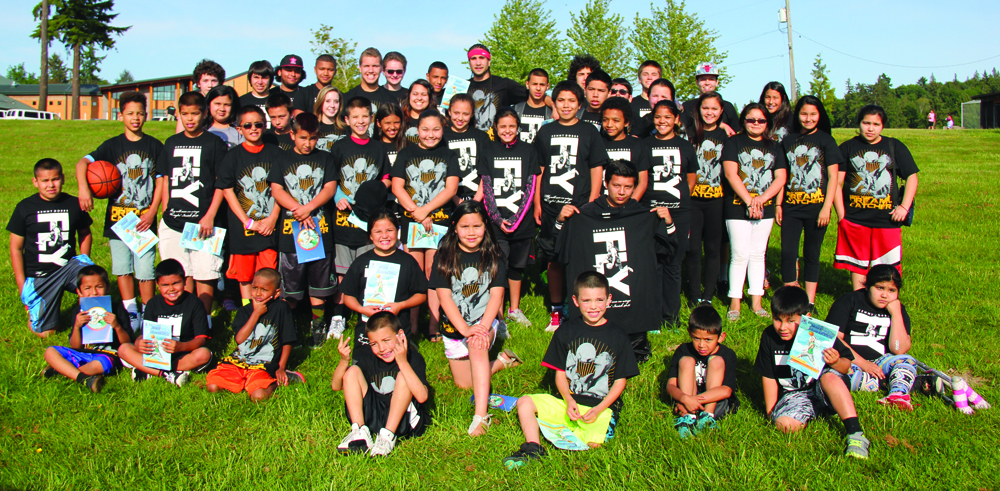
Photo/Micheal Rios
Contact Micheal Rios, mrios@tulaliptribes-nsn.gov
What’s Lurking Behind the Suicides?
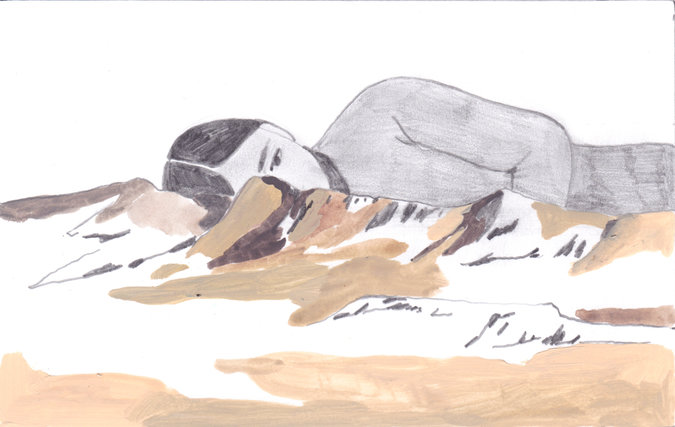
By Joe Flood, New York Times
PINE RIDGE, S.D. — OUTSIDE the Oglala Lakota tribe’s child protection service office, staff members updated a police officer on the latest emergency: An 11-year old girl had texted her cousin that she wanted to kill herself and then had gone missing.
A damp breeze swirled smoke from the caseworkers’ cigarettes, and the sun flitted between mottled clouds, the advance guard of an approaching spring blizzard. The officer jotted down some specifics on the girl and the remote area where she was last seen, then pulled away from the curb. They didn’t want to lose another child.
Since December, nine people between the ages of 12 and 24 have committed suicide on the Pine Ridge Indian Reservation — home to Crazy Horse’s Oglala band of the Lakota — in southwestern South Dakota.
They come to Pine Ridge every few years, these suicide epidemics, with varying degrees of national media attention and local soul-searching. What the news media often misses though, and what tribal members understand but rarely discuss above a whisper, is that youth suicides here are inextricably linked to a multigenerational scourge of sexual abuse, with investigations into possible abuse now open in at least two of the nine recent suicides.
I’m a wasicu (Lakota for “white person”) from Massachusetts, but I’ve spent about half of the past decade living on the rez, working mostly as a teacher and archery coach. Within two weeks of starting my first job teaching high school English here, a veteran teacher told me something he thought was critical to understanding life on Pine Ridge: By the time they reach high school, most of the girls (and many boys, too) have been molested or raped.
His anecdotal observation seems to track with the available statistics. According to the United States Department of Justice, Native Americans are 2.5 times more likely to be sexually assaulted than other Americans, and the numbers on Pine Ridge, one of the largest, poorest reservations in the country, appear to be even greater. “We started two clinics for reproductive health in the largest high schools on the reservation,” said Terry Friend, a midwife who works at the year-and-a-half-old Four Directions Clinic, which specializes in sexual assault and domestic abuse. “When I take a sexual history of a patient, I ask, ‘Have you had sex against your will?’ At the high schools, girls answered yes more than no.”
Numbers are harder to come by for boys, but local medical professionals estimate that they are also high, and that such rates of abuse can translate to high rates of suicide. One recent study found that nationally, teenage boys who were sexually assaulted were about 10 times more likely to attempt suicide, girls more than three times more likely.
At some point, most local child sexual assault cases cross the tribal prosecutor’s desk. “Unfortunately, many of those same kids have suicidal ideations and attempts,” said the tribe’s attorney general, Tatewin Means. “I definitely think there’s a strong connection between sexual assault and suicide here on the reservation.”
Advertisement
THE BOY LOVED the sweat lodge. He was a troubled student but took solace in the traditional Lakota form of prayer, with steam hissing off big glowing rocks in the center of a small lodge made of bent saplings and canvas tarps. School and tribal officials said the boy showed up to school one day last spring when he was supposed to be on suspension, climbed a pine tree in the schoolyard and hanged himself from a thick branch. Teachers and students saw him, and he was quickly cut down. Struggling to breathe, he sprinted for the school’s sweat lodge, where he took refuge until the police and a relative calmed him down.
It wasn’t the first time he had attempted suicide in or around school grounds, administrators said. He’d been depressed, and behaving erratically, with signs that he was using drugs and “huffing” gasoline. There had also been signs of sexual abuse, involving not only him but also a younger brother and male cousins he lived with. Every time one of the boys showed new signs of abuse or talked about suicide, school officials said, they called the tribe’s child protection unit, and every time they were told the same thing: “It’s still under investigation.”
The child was not removed from the home. Then in December, two weeks after his 14th birthday, the boy hanged himself at home and became the first in the recent string of nine suicides.
His case was lost, it seems, in the web of tribal bureaucracies and federal oversight bodies that are long on backlogged cases and short on funding. The tribal child protection unit, for instance, currently has two investigators for the entire reservation, which the federal census puts at more than 18,000 total residents (though tribal officials say is closer to 40,000). The two investigators are responsible for handling upward of 40 new cases a month, and hundreds more in the long-term case management system.
About a month after the boy died, a 14-year old cheerleader killed herself. Soon after, rumors of an all-too-familiar detail started to spread: Before her death, the girl told friends that her stepfather, a longtime teacher and coach at her school, was sexually abusing her. What followed broke the usual mold, though: Her friends came forward to tell school officials. Charles Roessel, a member of the Navajo Nation and director of the federal Bureau of Indian Education, which oversees the school, said administrators acted quickly to suspend the accused teacher and refer the case to federal investigators. No charges have been brought.
Shortly after his suspension from the federal school, the cheerleader’s stepfather was brought on, according to school officials, as an unpaid intern by the reservation’s Shannon County school system, which is overseen by the state. His job was to shadow one of the system’s principals so that he could learn to be a school administrator. The stepfather did not respond to requests for comment.
TRIBAL LEADERS and experts are struggling to understand the recent suicide epidemic (specifics on many of the cases aren’t widely known), but there’s general agreement on one underlying cause: the legacy of federally funded boarding schools that forcibly removed generations of Native American children from their homes. Former students and scholars of the institutions say that the isolation and lack of oversight at the mostly church-run schools allowed physical and sexual abuse to run rampant.
“My grandmother used to tell me that she didn’t think she was pretty,” said an E.M.T. friend of mine who responds to a suicide attempt every week or so, “because when the priests used to sneak into her dorm and take a little girl for the night, they never picked her.”
Left untreated, such sexual abuse can lead to elevated rates of drug and alcohol abuse and suicide, said Dr. Steven Berkowitz, director of a center on youth trauma at the University of Pennsylvania.
One sad irony of the recent suicides is that they come in the middle of new initiatives to address sexual assault. The Four Directions Clinic is treating young abuse victims who were previously sent to distant hospitals off the reservation. Tribal and federal law enforcement officials now confer regularly to better coordinate investigations. High school students recently petitioned the Pine Ridge school board to create health classes for vulnerable middle school students, and the board unanimously voted to find necessary funding.
Still, the challenges are enormous. Six days after the 11-year-old girl went missing, protection services still hadn’t located her, though a caseworker says the hope is that the girl and her mother have gone to a domestic violence shelter somewhere — the reservation doesn’t have its own.
Shortly before the 14-year-old boy committed suicide, a school administrator tried to counsel him. Lakota tradition, she told him, teaches that a spirit set free by suicide is doomed to wander the earth in lonely darkness. “You don’t want that, do you?” she asked. He looked her in the eye, a minor taboo for Lakota children to do with their elders, and said, “Anything’s better than here.”
E-cigarette use outpacing cigarette use among teens
Governor Jay Inslee gives sobering statistics for Washington youth
“What we’re seeing is alarming,” said Dr. Gary Goldbaum, health officer and director at the Snohomish Health District. “The companies marketing these products are zeroing in on youth with ads featuring celebrities and other social media campaigns telling them that vaping is cool and safe. These are dangerous messages to send to our kids.”
Electronic cigarettes, also known as e-cigarettes or vaping devices, represent a market that has grown exponentially since they were first introduced in mid-2000s. They are typically equipped with a battery, an atomizer, and a cartridge for liquid nicotine. There are more than 400 different brands of e-cigarettes and the liquid nicotine comes in more than 7,000 flavors, all of which can be purchased online. The devices can also be used with marijuana, heroin, and other drugs.
The devices are not regulated by the Federal Drug Administration, so manufacturers are not required to disclose product ingredients. In addition to the nicotine, vaping may expose users and by-standers to harmful toxins like lead and formaldehyde. It will take decades to fully understand long-term effects of e-cigarettes and exposure to vaporized nicotine and other drugs.
“Nicotine is nicotine, regardless if smoked or vaped. We can’t afford to let years go by before acting to protect teens from a lifetime of health problems,” said Goldbaum. “This is a drug that the U.S. Surgeon General has noted is just as addictive as cocaine and heroin. We need to do more to protect our children–it’s critical that our legislators do what is in their power to keep these harmful devices off limits to Washington’s youth.”
A bill is currently under consideration during this legislative session. If approved, it would require retailers obtain licensing for the sale of vaping devices, prohibit internet sales, ensure child-safe packaging, and restrict marketing and sales activities targeted at youth. It would also impose a tax on vaping products that would be on par with other addictive substances like alcohol and tobacco. Taxing tobacco products has proven to be one of the most effective strategies to reduce the use of harmful and addicting substances, particularly among youth.
The final 2014 Healthy Youth Survey data and reports will be released by the Washington State Department of Health next month.
Snohomish Health District works for a safer and healthier community through disease prevention, health promotion, and protection from environmental threats. To read more about the District and for important health information, visit www.snohd.org.
President Obama Wants $1 Billion for Indian Education
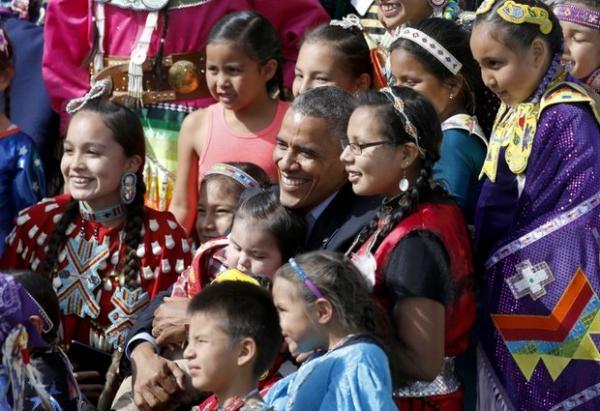
President Barack Obama poses with Native America dancers during his visit to the Standing Rock Indian Reservation Friday, June 13, 2014, photo in Cannon Ball, North Dakota.
President Barack Obama’s 2016 budget request includes $1 billion to transform American Indian education, a $138 million increase from the current funding level.
The transformation would change the Bureau of Indian Education into “an organization that serves as a capacity builder and service provider to support tribes in educating their youth and deliver a world-class and culturally appropriate education across Indian Country.”
The $138 million increase would include $58.7 million for school repairs and replacement; an initial $34.2 million to deliver broadband access to all BIE schools; an additional $20 million for operations and maintenance at Indian school facilities; $75 million (an increase of $12.9 million) to fully fund tribal costs for running their own education programs; an additional $10 million “to incentivize creative solutions to school transformation”; and $2.6 million to improve school administration.
The increased American Indian/Alaska Native education funding request is part of the launch of the president’s Generation Indigenou sinitiative intended to reduce barriers to success for Native American youth. The Gen I initiative also includes a small increase for scholarships and adult education, $3 million to support 60 new tribal youth projects in natural resources, a $15 million increase for the Tiwahe Initiative and $4 million to establish a One-Stop Tribal Support Center. Funding for Native Youth Community Projects would increase by a whopping $50 million (up from $3 million) to improve college and career readiness among Native youth.
Interior Secretary Sally Jewell; Assistant Secretary for Indian Affairs Kevin Washburn, Chickasaw; Education Secretary Arne Duncan; and Jodi Gillette, special assistant to the president for Native American affairs, held a teleconference on January 29 to begin to create public support for the education initiatives.
Jewell noted that the president’s recommendations would provide the highest level of funding for AI/AN education since the American Recovery and Reinvestment Act of 2009.
Duncan said, “The lack of opportunity [for Native American youth] is simply unacceptable… At every level, early childhood, K to 12, higher education, we have a lot of hard work ahead of us… Tribes need to play a meaningful leadership role in the education of their students. We know that tribes are best able to know their own students’ needs and best able to build upon their strengths.”
Asked what chance the AI/AN education proposals had to make it through the Congressional appropriations process, Jewell said, “There is strong bipartisan support for addressing the issues that we talked about and identified here today… There is no question that we are not serving Indian children well and I think there is a sense of appreciation that we are tackling these things head-on and we’re not just kicking the can down the road as has been done by both Democratic and Republican administrations for many years. I am quite optimistic that we will get support for this budget.”
U.S. Rep. Tom Cole, Chickasaw, a Republican representing Oklahoma’s 4th District, said in a statement: “Throughout President Obama’s tenure, Native American issues have proven to be a source of bipartisan cooperation, particularly on the House Appropriations Committee… In the days ahead, as my colleagues in the House and Senate seek to find common ground with the Administration, I remain hopeful that we can make significant progress in Indian country during this session of Congress.” Cole serves as chairman of the House Appropriations Subcommittee on Labor, Health and Human Services, Education and Related Agencies and on the House Budget Committee.
Congresswoman Betty McCollum, D-Minnesota, said in a statement: “The Bureau of Indian Education has long been underfunded and meeting our trust and treaty responsibility for educating Native American children will not happen overnight… President Obama and Secretary Jewell have taken a significant action to set us on a path towards ensuring that all children in Indian Country have access to a safe place to learn.” McCollum is the ranking Democratic member on the Interior Appropriations Subcommittee and the Democratic co-chair of the Native American Caucus.
In response to a question from ICTMN about whether other AI/AN programs would be cut in order to fund the education initiative, Washburn responded, “We have not made significant compromises” in developing the budget.
Jewell said the president’s commitment to the American Indian community, based in part on his June visit to the Standing Rock Sioux Reservation in North Dakota and December’s White House Tribal Nations Conference, was instrumental in developing the FY16 budget requests for AI/AN education. She noted that the administration would launch a Cabinet Native Youth Listening Tour next week to hear directly from AI/AN kids.
Read more at http://indiancountrytodaymedianetwork.com/2015/02/02/president-obama-wants-1-billion-indian-education-158971
Being safe on social media
By Kara Briggs-Campbell, Special to Tulalip News
Social media is a player in every aspect of society these days.
Its profound impact hit home for the Tulalip Tribes after the tragic school shooting as an outpouring of grief, resentment and anger seemed to flow in every direction. Tulalip leaders called upon families to stop using social media all together in the weeks that followed, or at least not post in anger something that would be regretted later.
Off the reservation, law enforcement contacted those who posted hateful messages toward the tribe and its members, while regional and national news media scoured social media posts for information and photos of the victims.
Social media is an important form of communication for teens and adults. Increasingly, it is used in suicide prevention and education as way to directly inform teens and young adults, said Dr. Richard McKeon of Substance Abuse and Mental Health Services Administration.
“Social media is here to stay and it is up to those who use it to use it wisely,” he said.
Social channels are increasingly cooperating with organizations that seek to prevent everything from bullying to suicide.
In 2013, the National Suicide Prevention Lifeline announced its partnership with Facebook, which allows Lifeline to connect via an online chat with people who are posting suicidal ideas. Users can report suicidal posts by a friend on their news feed by clicking “mark as spam” then on the pop up screen choose, “violence or harmful behavior,” on the next pop up choose, “suicidal content.” Or enter your friends name or contact information.
U.S. Surgeon General Dr. Regina Benjamin, when announcing the partnership in 2011, said, “We must confront suicide and suicidal thoughts openly and honestly, and use every opportunity to make a difference by breaking the silence and suffering.”
Social media for many of us is more than just a tool. It is a way that we connect, stay in touch, entertain ourselves and share information.
Laura van Dernoot Lipsky, founder and director of the Trauma Stewardship Institute, said finding the people who are healthy for you to be around is the same on social media as it is in real life.
“People need pay very close attention to who they are spending time with,” she said. “It is a turning point in life when you can give thought to who you spend your time with.”
The same way someone in sobriety should avoid the old friends they used to drink and use with in person, they also need to avoid them online.
Social media can be beneficial for people who feel isolated and need to interrupt the isolation, she said. But if people are going online and reading negative stuff that is poison.
“The question is what do you take in? You can drink a lot of water and its good, or you can drink a lot of poison and it will kill you,” Lipsky said.
In a tribal community meeting last month with Dr. Robert Macy who is president of the International Trauma Center in Boston, tribal parents talked about the pressure that social media places on teens. Some talked about complex decisions to monitor teen’s online presence at the same time as respecting their privacy.
Macy said as long kids are dependent upon their parents to pay the rent and keep the lights on, parents have the responsibility to monitor everything that happens in their rooms or on their Facebook page or Twitter feed. For parents, the attitude must be, “I love you too much to let you hurt yourself.”
Macy had a warning for parents too.
Being too connected electronically can make you disconnected personally.
A 2014 study published in the Journal Academic Pediatrics found that mothers were regularly distracted at meal time by their smart phones. Overall, the study found that the use of cell phones and other devices during meals was tied with 20 percent fewer verbal interactions between mothers and their children, and 39 percent fewer nonverbal interactions. Those who had the highest use of mobile decides during meals were far less likely to provide encouragement to their children, researchers found.
So Macy urged the tribal families gathered to put their smart phones away during family time, and if you visit a friend, leave the phone at home or in the car. Then use the time to make a real person-to-person connection with someone you love.
Tips for students using social media
This list is based upon one published on the website of Carlton University in Canada. The tips are geared to college students, but apply as well to younger teens and for that matter to adults. The concern that Carlton University raises is that your social media posts will last forever on the World Wide Web. It is not overstating to say that this is new era in the history of the world. In past generations you could put your past behind you, you could move away, change your outlook. Now, if you have posted your life digitally on your social media sites, it will live online and be searchable by people in your future.
Privacy: Set all of your social networking accounts to private and maintain your privacy settings so you avoid posting too much personal information. On Facebook, don’t forget to set your privacy settings to include photos and videos that others post of you to avoid being found via basic Web searches.
Don’t over share: Don’t say anything you wouldn’t normally share with a prospective employer or your mother or your grandmother.
Stay offline when under the influence: If you’ve just spent a night partying with friends, keep your computer off, or your online mistakes could come back to haunt you. Sometimes referred to as “drunk Facebooking,” posting inappropriate comments or photographs while inebriated may cast a negative reflection on your online persona.
Stop Complaining: Avoid speaking negatively about school, current or previous jobs, family or friends. Similarly, don’t update your Facebook status only when you have something negative to say; find a balance so your digital persona doesn’t look too angry.
Separate social networking from job networking: Avoid using social networking sites like Facebook for professional or scholastic networking, and build up your career contacts on other sites like LinkedIn.com.
Generate positive content: Experts agree that the best way to counteract negative content is by generating positive information that will rank high on search engines like Google.
Where can I call for help?
To report an emergency dial 911
National Suicide Prevention Line: 1-800-273-TALK (8255)
Snohomish County Crisis Line: 1-800-584-3578
Crisis TEXT Line: Text “Listen” to 741-741
24 Hour Crisis Line: 1-866-427-4747
TEENLINK: 1-866-833-6546
Tulalip Tribes Behavioral Health Family Services: 360-716-4400
Obama unveils plan to help young American Indians
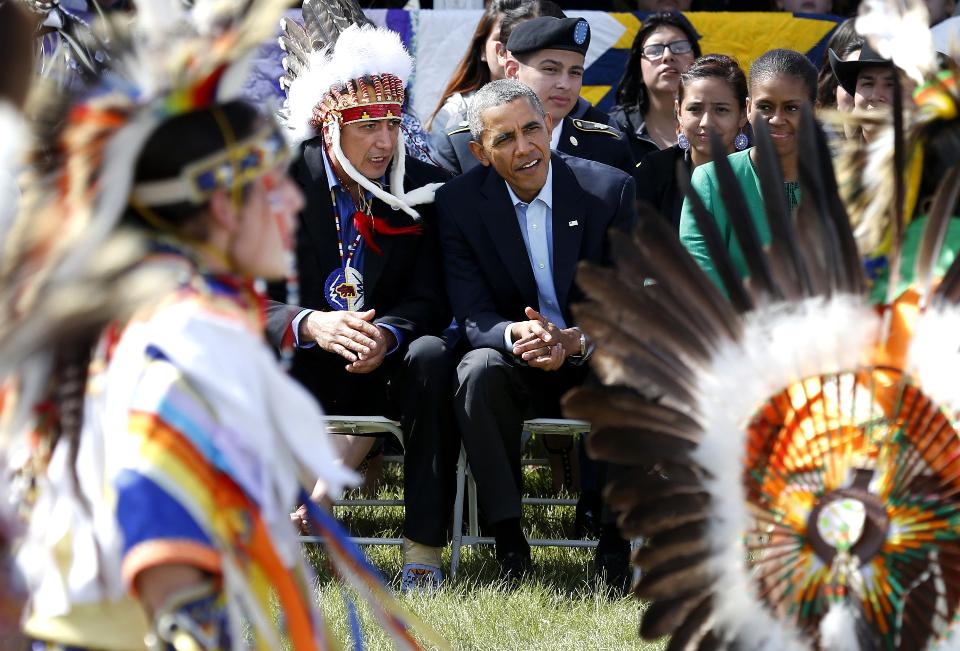
By Blake Nicholson, AP
BISMARCK, N.D. (AP) — President Barack Obama announced an initiative Wednesday aimed at improving conditions and opportunities for American Indian youth, more than a third of whom live in poverty.
Obama’s Generation Indigenous initiative calls for programs focused on better preparing young American Indians for college and careers, and developing leadership skills through the Department of Education and the Aspen Institute’s Center for Native American Youth. Members of the president’s staff also plan to visit reservations next year.
The White House did not provide a cost estimate for the initiative, but a spokeswoman said the administration plans to fund it with existing money and the help of nonprofit and philanthropic organizations.
The announcement, made as part of the White House Tribal Nations Conference that Obama is hosting on Wednesday, comes five months after the president and his wife visited the impoverished Standing Rock Indian Reservation in the Dakotas.
The 3,600-square-mile reservation is home to about 8,500 people, many of whom live in run-down homes, and where the unemployment rate runs as high as 20 percent. The suicide rate for American Indians aged 15 to 24 is more than twice the national rate.
Cecilia Munoz, director of the White House Domestic Policy Council, said the president and first lady “were deeply moved” after listening to children’s stories about challenges they faced on the reservation, such as depression and alcohol abuse. Vice President Joe Biden said in a morning appearance before the conference that for Obama, helping Indian youth is “something that he came back from his June visit fired up about doing something about.”
Wednesday’s conference involves leaders from 566 federally recognized tribal nations, along with 36 White House Youth Ambassadors chosen from around the country through an essay contest.
“People who grow up in a poverty culture sometimes need guidance, need values, need a little bit of structure,” said Chase Iron Eyes, an attorney and Native American rights activist from Standing Rock who is attending the conference.
“Through some of the things the administration is doing, it looks like they’re trying to do that,” he said. “Youth — they just need the right tools, and maybe they can empower themselves.”
The White House also released a report Wednesday acknowledging failures in federal policy and highlighting the need for more tribal help in the areas of economic development, health and education. Slightly more than two-thirds of Native youth graduate from high school, according to the 2014 Native Youth Report.
One of the report’s recommendations is to strengthen tribal control of the education system on reservations. Officials are working to overhaul the Bureau of Indian Education, which is responsible for educating 48,000 Indian students in 23 states, Interior Secretary Sally Jewell said.
Jewell estimated it would cost more than $1 billion to fix schools with crumbling infrastructures. Officials are pursuing money through Congress, existing government programs and philanthropic organizations.
“We have to get creative,” Jewell said.
Tulalip Healing: A Challenging Time for Tribal Youth
By Kara Briggs-Campbell, Tulalip News Guest Writer
Weeks and months after the tragic events of Oct. 24, many Tulalip youth are likely to still be grappling with deep feelings and complex emotions associated with grief, experts say.
The key for adults and even peers will be keeping a lifeline of connection with tribal youth as they move from feelings of shock and trauma to grief and loss.
“The hardest part with teens is that their developmental task in normal times is to push away from their parents,” said Alison Bowen, Family Healing Program Coordinator for the Tulalip Tribes. “It’s like, ‘Love you, mom. Gotta go.’ Yet even as they are pushing you away, the challenge is how to reconnect with them in this time of trauma.”
Sudden behavioral changes are one of the signs that an adolescent or teen is struggling emotionally. These shifts can include examples such as, a youth, who usually rises early to get ready for school, suddenly doesn’t care; An outgoing kid isolates herself or himself; A teen detaches from his or her friends.
“If all of sudden any kind of big change happens that is what you want to watch for,” Bowen said.
The people most likely to notice such changes are friends of the same age group. That’s why specialists say the best thing now is to let the kids be together, whether they are playing basketball, making art, talking or even sitting still together.
A major concern is if a youth is thinking a lot about death, or meditating on a past hurt, or unable to think about anything but the recent losses of life.
“It is important to listen and do what you can to encourage the person to get help,” said Dr. Richard McKeon, Branch Chief of the Center for Mental Health Services.
For the very most vulnerable, the concern is preventing youth suicide—knowing that among American Indians aged 10 to 24 suicide rates are higher than in the same age group among other races.
“It is important not to be frightened to ask the question whether someone is thinking about suicide,” he said. “The research shows that if you ask a youth and they say no, they aren’t going to start thinking about suicide because you asked.”
“But if someone appears to be depressed or hopeless, it is important to ask the question and not to panic if the answer is yes,” McKeon said. “For a person who is in trauma and potentially thinking about suicide it is essential that make a connection with someone.”
One way a teen could support a friend is by helping them to make contact with a trusted adult. Sometimes that adult is a parent or a favorite aunt, uncle or grandparent. Other times it may be the Native liaison at school or a staffer at the Tulalip Boys and Girls Club. Ultimately the youth might need mental health counseling, but in the immediate term, a trusted adult can make all the difference in the world.
“We know in the days ahead we are going to have more kids dealing with grief and anger and more kids who are anxious and scared,” Bowen said.
The best ways a friend can help now are to be available, to listen respectfully as the person who is sad or in trauma pour out their feelings, or sit quietly if they just want company.
“It’s hard that we’re asking people to take care of the youth when everyone’s hearts are so heavy,” Bowen said. “That’s why it can’t only be a family looking after their own kids, it has to be all of us pitching in to help.”
Where can I call for help?
- To report an emergency dial 911
- National Suicide Prevention Line: 1-800-273-TALK (8255)
- Snohomish County Crisis Line: 1-800-584-3578
- Crisis TEXT Line: Text “Listen” to 741-741
- 24 Hour Crisis Line: 1-866-427-4747
- TEENLINK: 1-866-833-6546
- Tulalip Tribes Behavioral Health Family Services: 360-716-4400
- Tulalip Tribes Mental Wellness Director Sherry Guzman: 360-716-4305
A letter of hope to Tulalip tribal youth from a survivor from the Red Lake Nation
Justin Jourdain was a ninth grader when he witnessed the school shooting at Red Lake High School. A Red Lake tribal member, Justin was friends with classmates who died and others who were injured. Now a Red Lake Nation police officer with a family of his own, Justin wanted to travel to Tulalip to meet with and encourage tribal youth in person, but his work schedule got in the way. So Justin has written an open letter to Tulalip youth and provided it to the See-Yaht-Sub.

Photo courtesy of Justin Jourdain
Boozhoo! This is the way we greet each other in my tribe, the Red Lake Nation in Northern Minnesota.
You may not realize it right now, but everything will get better with time.
If you witnessed this tragic event or you were at school that day, you will always remember, as I do those terrifying moments. But in a few weeks and then a few months, it will get easier. You will gain perspective from having lived through this traumatic time in your Tribe’s history. Believe me, surviving can change your life for the better, if you let it.
In the days after the Red Lake School shooting, survivors from Columbine High School met with my classmates and me. The contact with the others who had the same experience gave me the courage to hope again for the future, though I lived with the memory very strongly until 2008 when I graduated from high school, and that helped me to find closure.
I know firsthand how important it is to meet people who share this still unusual experience. That inspired me to go to reach out to other students at schools where this has happened. I feel that it helps just to meet and spend time with someone who knows what this experience felt like. It is important to the healing process to feel that someone knows what it was like. In time, you may have the opportunity to help someone else heal, though it is always my hope that nothing like this ever happen again.
Healing will be a long process, but you will get better. You will remember for the rest of your life. For me nine year later, I can still remember that day as if it were yesterday. But I’ve learned to deal with the pain and continue living. You will learn to cope as I have.
Today I am married and I have a six-year-old son. For the last four years I have worked in law enforcement for my tribal police. I am 25 years old.
In 2005, I was freshman in high school and I couldn’t conceive of all the good things ahead. But stick in the back of your mind that the rest of your life is waiting for you to live it. Believe that things will get better as you let go of the pain and move forward in your life.
Your friend from the Red Lake Nation,
Justin Jourdain
Klamath Youth Program Melding Science and Traditional Knowledge Wins National Award
Source: Indian Country Today Media Network
A unique collaboration between a Klamath youth leadership development program and U.S. government researchers has won the U.S. Department of the Interior’s Partners in Conservation award for its use of traditional knowledge in conjunction with modern science.
The Klamath Tribal Leadership Development for Integrative Science and Traditional Ecological Knowledge Program, operating in northern California and southern Oregon, was one of just four recipients working with the U.S. Fish and Wildlife Service, the Klamath Tribes said in a media release. The partnership was one of 20 recipients overall out of groups working with various federal agencies on environmental conservation and won for its work in habitat restoration and the implications for fisheries management.
The cornerstone was the Klamath tribal youth program, started last summer to connect scientists and college students to Klamath Basin restoration projects. Juxtaposing traditional knowledge and modern science, youths from the Yurok Tribe, Hoopa Valley Tribe, Karuk Tribe, Quartz Valley Indian Reservation and Klamath Tribes worked with scientists from NASA, the U.S. Fish and Wildlife Service, the U.S. Geological Survey and the U.S. Forest Service for 10 weeks in the Klamath Tribal Leadership Development Program for Integrative Science and Traditional Ecological Knowledge. Together the partners restored habitat, developed models and collected data from two Klamath watershed tributaries, the Sycan River in Oregon and Shasta Big Springs Creek in California, that support tribal fisheries, the Klamath said in the statement.
The U.S. Department of the Interior noted the unique melding of tribal cultural knowledge with today’s technology that got the program chosen out of the 14 partnerships that were nominated for the award by the U.S. Fish and Wildlife Service. Students worked first with tribal elders to gather ancestral knowledge of the region’s lands and waterways, then applied that knowledge to programs whose goal is to restore and manage native fish populations in the Klamath Basin. At the same time, the program gave tribal youth job skills, setting them up as future conservation leaders even as they contributed to present-day management of fish species that are important to indigenous culture and the ecology, the Fish and Wildlife Service said in a release.
“This partnership has the promise to result in some of the most advanced approaches to fisheries management in the country and will help prepare tribal youth for future careers in conservation,” the Fish and Wildlife Service said. “To date, these agencies have brought their collective resources and expertise with established and emerging technologies and have applied these to this collaborative effort, including remote sensing and unmanned aircraft systems. These technologies hold promise for improving our knowledge base and conservation effectiveness through energy efficient, cost-effective approaches to data collection with less impact on our ecosystems.”
Other partners involved were the Nature Conservancy, Humboldt State University, Southern Oregon University and the Oregon Institute of Technology, the Klamath statement said.
“The Department of the Interior is proud to recognize the accomplishments of those who are innovating and collaborating in ways that address today’s complex conservation and stewardship challenges,” said Department of the Interior Secretary Sally Jewell, who handed out the awards on January 16. “These partnerships represent the gold standard for how Interior is doing business across the nation to power our future, strengthen tribal nations, conserve and enhance America’s great outdoors and engage the next generation.”

Read more at http://indiancountrytodaymedianetwork.com/2014/01/27/klamath-youth-program-melding-science-and-traditional-knowledge-wins-national-award
Kids Fly a Kite for Science
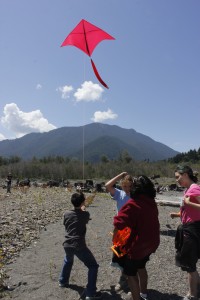
Source: Northwest Indian Fisheries Commission
Lower Elwha Klallam Tribe youth collected data for the U.S. Geological Survey by flying a kite over the Elwha River this summer.
As part of a science-based summer camp focusing on the Elwha River restoration project, the kite was collecting data about the ever-changing Lake Aldwell delta. The red kite had a small digital camera attached to the fly line, set up to take pictures of the ground below every three seconds.
The USGS is collecting aerial photos to document the rapidly changing deltas of the Elwha River during removal of the Elwha and Glines Canyon dams, said KC Nattinger, a field science educator with NatureBridge, a Lake Crescent-based science education camp.
“It’s a great project for the kids since it allows them to participate in a science experiment in an area that they are culturally tied to,” Nattinger said.
In addition to flying kites, the kids took water quality samples, explored old tree stumps and driftwood, and learned about the tribe’s cultural ties to the river.
Klallam language teacher Harmony Arakawa talked about rediscovery of the tribe’s creation site. It had been under Lake Aldwell reservoir for a century until the Elwha Dam was removed last summer, draining the reservoir.
Arakawa talked about the site and its purpose. Tribal members would go on spirit walks to the creation site, first bathing themselves in the river and Olympic Hot Springs and then walk to the creation site seeking a vision.
Wendy Sampson, another Klallam language teacher, told the kids they are in the middle of history and are collecting stories that they will share with future generations.
“You kids are part of history,” she said. “You were some of the last kids whose picture was taken in front of the Elwha Dam before it came down.”
The stories passed down by older generations explaining how the river has changed has been backed by the science taking place on the river recently, Sampson said.
“These stories aren’t just stories,” she said. “We’re seeing evidence of the stories that our elders have told us.”


